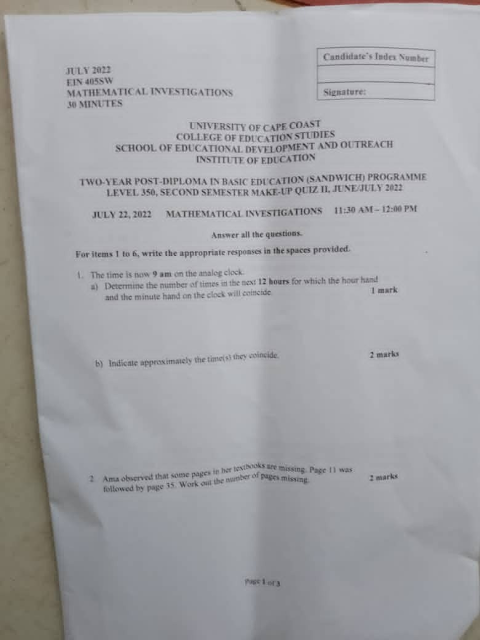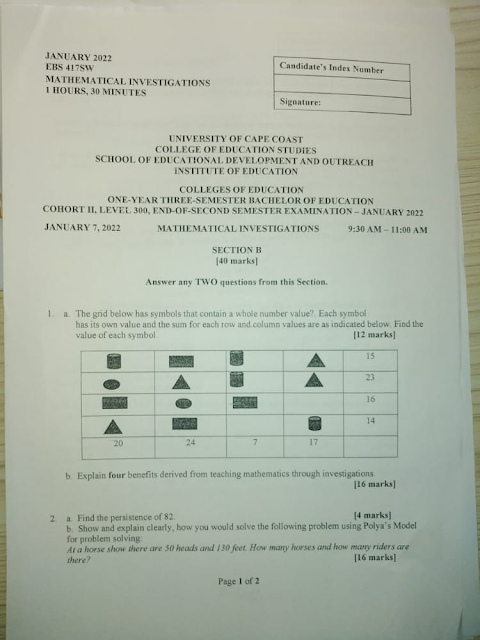- Back to Home »
- MOST LIKELY : MATHEMATICAL INVESTIGATIONS(WITH MARKING SCHEMES)
MOST LIKELY : MATHEMATICAL INVESTIGATIONS
CLICK ON THE IMAGES TO ENSURE CLARITYTRIAL 1COHORT II WITH SCHEME
DOWNLOAD THE FULL DOCUMENT BELOW
UNIVERSITY OF CAPE COAST
COLLEGE OF EDUCATION STUDIES
SCHOOL OF EDUCATIONAL DEVELOPMENT AND OUTREACH
INSTITUTE OF EDUCATION
COLLEGES OF EDUCATION
FOUR-YEAR BACHELOR OF EDUCATION (B.ED)
FOURTH YEAR, SECOND SEMESTER MID-SEMESTER QUIZ, SEPTEMBER 2022
MARKING SCHEME
COURSE CODE: EBS 417
COURSE TITLE: MATHEMATICAL INVESTIGATIONS
Answer ALL the questions.
[20 MARKS]
1. A general suggestion or strategy independent of any particular topic or subject matter that helps problem solvers approach and understand a problem and efficiently marshal the resources to solve it is known as a/an ……………
A. Formula.
B. Heuristic.
C. Rubric.
D. Skill.
2. Which of the following are examples of general strategies problem solvers employ when solving problems?
I. Acting it out
II. Looking at all possibilities
III. Relaxing a condition
A. I and II only
B. I and III only
C. I, II and III
D. II and III only
3. In solving the following task, “Find all rectangles with integral sides whose area and perimeter are equal”, a learner started as follows: Let l be the length of a rectangle and w be its width. The strategy used by the learners is an example of …………….
A. drawing a diagram.
B. identifying the givens in the task.
C. selecting an appropriate notation.
D. writing an open sentence.
4. The two factors that inform the strategies used by problem solvers are ……………
I. Sophistication level of the problem solver
II. Level of Motivation
III. Familiarity with related task
A. I and II only
B. I and III only
C. I, II and III
D. II and III only
5. The question, “What relevant previous knowledge do I need in order to solve this problem?” falls under which one of the following steps proposed by Polya?
A. Carrying out the plan.
B. Devising a plan.
C. Looking back.
D. Understanding the problem.
6. The question, “What do I want?” falls under which one of the three phases proposed by John Mason?
A. Attack.
B. Entry.
C. Retreat.
D. Review.
7. The Define stage under the ‘IDEAL’ Model is similar to which one of the following steps by Polya?
A. Carrying out the plan.
B. Devising a plan.
C. Looking back.
D. Understanding the problem.
8. Which of the following is not a characteristic of a good problem solver?
A. Engage in the reversibility of thought
B. Make use of multiple strategies
C. Search for an underlying structure
D. Very quick in solving tasks
9. The learning theory that suggests that learners conceive of concepts differently and do not simply reproduce what teachers tell them is known as ……………
A. Behaviourism.
B. Cognitivism.
C. Constructivism.
D. Sociocultural theory.
10. All the following are principles that should guide the mathematics teacher when implementing a mathematical investigation task except ……………
A. allow learners to engage in predictions.
B. ignores errors made by learners.
C. model a useful problem-solving method.
D. teach with a specific context.
11. The approach to the teaching of problem-solving or investigations where learners are first taught the mathematical skills, given the opportunity to practice the skills and then presented with a problem task to solve is known as Teaching …………… problem-solving.
A. about
B. against
C. for
D. through
12. Which of the following are reasons why the traditional way of teaching problem solving was not effective?
I. It leads to a belief that there is only one way of solving mathematical tasks.
II. Most often, learners do not acquire the requisite knowledge.
III. The learner is an active participant in the teaching-learning process.
A. I and II only
B. I and III only
C. I, II and III
D. II and III only
13. In a mathematics class, the teacher taught the learners various strategies that can be used to solve future mathematical tasks. The approach used by the teacher is known as teaching …………… problem solving.
A. about
B. against
C. for
D. through
14. The question, “What is staying the same, what is changing?” falls under which one of the following strategies for problem solving?
A. Formulating conjectures and justification of claims.
B. Looking for a pattern.
C. Predicting and checking for reasonableness.
D. Visualising the problem.
15. Prior to allowing the learners to actually carryout the investigation into the task, the mathematics teacher asked them to write down what they expect the answer to be. The strategy used by the teacher is known as ……………
A. formulating conjectures and justification of claims.
B. looking for a pattern.
C. predicting and checking for reasonableness.
D. visualising the problem.
16. There are seven players in a lawn tennis tournament. Each person plays one game with every other player. What is the total number of games played in the tournament?
A. 7
B. 14
C. 21
D. 28
17. The second stage in the ‘IDEAL’ model of problem solving is ……………
A. decide learning outcomes and solve the problem.
B. define goals and represent the problem.
C. define the strategies to use and go ahead to implement it.
D. develop the motivation to solve the problem.
18. The ‘Explore possible strategies’ stage in the IDEAL model for problem-solving is similar to which of the following step as proposed by Polya?
A. Carrying out the plan.
B. Devising a plan.
C. Looking back.
D. Understanding the problem.
19. Which one of the following questions must a teacher ask first before choosing a worthwhile task?
A. Can learners demonstrate their mastery of mathematics through this task?
B. Do learners need to use their existing knowledge to complete this task?
C. Does it take more than one class period to complete the task?
D. Does the task call for the use of a single problem-solving technique?
Item 20 is a statement followed by True and False options. Read the statement carefully and indicate whether it is True or False by circling the letter of the correct option.
20. In engaging in problem solving approaches in the teaching of mathematics, the teacher is interested in students understanding the mathematical concepts.
A. True
B. False
DOWNLOAD DOCUMENT HERE



































